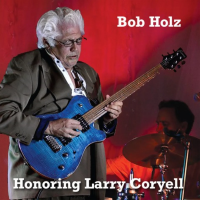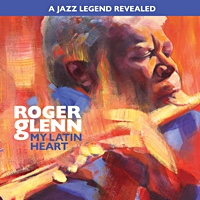Home » Jazz Musicians » Nat Adderley
Nat Adderley
Nat Adderley may have spent a significant part of his career in the shadow of his better known older brother, the alto saxophonist Julian 'Cannonball' Adderley, but he was always a major contributor to their shared projects, and achieved a great deal in his own right after his brother's death in 1975. He was born Nathaniel Adderley, and took up trumpet as a teenager in 1946. He began playing in local bands in Florida, and made what became a career long switch to the smaller cornet in 1950. He did so against the prevailing tide. Cornet had been the horn of choice for New Orleans trumpet players in the early days of jazz, but had fallen out of fashion in favour of trumpet by the bop era. Nat Adderley Adderley evolved a distinctive signature on the instrument, blending a rich tone and earthy warmth with the horn's inherent touch of astringency to great effect. He played in an army band for a time during his military service from 1951-3, then joined the band led by vibraphonist Lionel Hampton in 1954, his first association with an established jazz figure. He remained with Hampton until 1955, and cut his earliest recordings for the Savoy and EmArcy labels that same year. Cannonball Adderley had made an early mark in New York when he sat in with bassist Oscar Pettiford at the Cafe Bohemia in Greenwich Village in 1955, but that did not translate into immediate success when the brothers joined forces in Cannonball's Quintet the following year. He broke up the group in 1957, and Nat worked with trombonist J. J. Johnson and bandleader Woody Herman before reuniting with his brother in 1959. Nat AdderleyThe earlier lack of success quickly evaporated. The band's funky, gospel-tinged jazz became one of the most successful sounds on the hard bop and soul jazz circuit, and they even scored an unexpected chart hit with 'Mercy, Mercy, Mercy' in 1966. Cannonball had featured alongside John Coltrane in Miles Davis's classic Sextet which made the legendary Kind of Blue album in 1959, and that association provided the boost he needed to take off as a star in his own right, with the cornetist very much his right hand man. Nat had continued to record under his own leadership, and made his most famous record for the Riverside label in January, 1960, with a band which featured guitarist Wes Montgomery.
Read moreTags
Kelly Blue

by C. Michael Bailey
The classic Wynton Kelly Trio comprised Kelly on piano, bassist Paul Chambers, and drummer Jimmy Cobb. Besides being Kelly's most stable trio, this rhythm section provided the underpinning for several important recordings and tours for Miles Davis in the late '50s and early '60s. These include Kind of Blue (Columbia Records, 1959) and Davis' 1960 European Tours, Someday My Prince Will Come (Columbia Records, 1961), In Person, Vol. 1--Friday Night at the Blackhawk (Columbia Records, 1961), In Person, Vol. 2--Saturday ...
Continue ReadingCannonball Adderley: Burnin' In Bordeaux: Live In France 1969

by Stefano Merighi
Altra nuova perla della Elemental Music, e sempre con la produzione di Zev Feldman, “Burnin' in Bordeaux" (doppio CD) celebra il magistero di Julian Cannonball Adderley, un poeta assoluto del sax contralto, e la solidità nonché la brillantezza del suo quintetto di fine anni '60. Adderley, scomparso a soli 46 anni nel 1975, è stato fedele alla sua idea di jazz anche in un periodo in cui le trasformazioni si succedevano in fretta e in cui il grande ...
Continue ReadingCannonball Adderley: Poppin In Paris: Live At L'Olympia 1972

by Mike Jurkovic
In his most natural setting--onstage alongside brother Nat Adderley--and accompanied by pianist George Duke, bassist Walter Booker and the trusty Roy McCurdy on drums, Cannonball Adderley pops and bops to all heart's content on Poppin' In Paris: Live at the Olympia 1972 . Appearing as part of the Paris Jazz Festival, the band holds true to its unspoken credo--defy expectations--and steams straight ahead into Duke's epic rent party stomp “Black Messiah." It is a colorful jazz-rock fireworks display ...
Continue ReadingCannonball Adderly: Burnin’ in Bordeaux: Live in France 1969

by Mike Jurkovic
Intent on burning down the house, Burnin' in Bordeaux: Live in France 1969 finds Cannonball Adderley gleefully passing out the matches. Captured very, very, very live at the Bordeaux Jazz Festival in March 1969, Adderley and his fired up co-arsonists--pianist Joe Zawinul, cornetist Nat Adderley, Jr., bassist Victor Gaskin, and drummer Roy McCurdy--go scorched earth from the flare-up with Zawinul's spiky ember, the uber-toned “The Scavenger." It rips, it roars. It runs wild the rapids and holds strong the ramparts. It ...
Continue ReadingNat Adderley: A Player's Player

by Joan Gannij
This interview was originally conducted in 1997. I met Nat Adderley in San Diego, California in 1986 when I was working as a disc jockey at a jazz radio station and doing the PR for La Jolla Playhouse. We did an interview about a new production of a musical being revived at the progressive La Jolla Playhouse and premiered on Broadway later that year. “Shout Up a Morning," based on the folk hero John Henry, began as a ...
Continue ReadingNat Adderley: Naturally

by Derek Taylor
Fraternal partnerships are a frequent source of creative jazz inspiration. Reference the accomplishments of Montgomery brothers (Wes, Monk and Buddy) or those of the Jones clan (Elvin, Thad and Hank) for easy examples. And then there's Wynton, Branford, Delfayo and Jason, lest we leave out the Marsalises. Family ties have a way of forging lasting musical artistry, but the hobgoblin of rivalry can also enter into the equation when one sibling's star outshines those of the others.
Nat ...
Continue ReadingBenny Golson Quintet: That's Funky

by AAJ Staff
Looking back past the rule of Parliament to the age of Horace Silver, Benny Golson’s That's Funky pays tribute to Louis Armstrong through two renditions of his popular favorite “Mack the Knife." While the opening “funky version" starts off a bit sluggish and includes some pinched soloing by Nat Adderley, Monty Alexander’s firm comps make it swing and Golson’s smooth lines give it at least three pennies worth of class. On the “modern bebop version," Adderley’s lines are much more ...
Continue ReadingJohn Stubblefield + Nat Adderley

Source:
JazzWax by Marc Myers
Chances are you are unfamiliar with John Stubblefield. The obscure saxophonist was versatile and could play soul-jazz, funk-jazz and avant-garde jazz in the 1970s and beyond. Which probably is why he recorded with so many different types of artists and groups over the course of his career. Stubblefield brought enormous heat and polish to his solos, often sounding different with each artist. He recorded with Anthony Braxton in May 1972, toured with Charles Mingus in early 1973 and recorded with ...
read more
Nicolas Bearde's "Invitation," Produced By Nat Adderley Jr., Due January 29

Source:
Terri Hinte Publicity
Nicolas Bearde is a San Francisco Bay Area treasure. As a charter member of Bobby McFerrin’s Voicestra ensemble as well as the innovative vocal sextet SoVoSó, he’s long been internationally recognized as a versatile and fearless vocal improviser, charismatic performer, and distinctive jazz and soul stylist. While Bearde has drawn on his love for both R&B and jazz on his previous four CDs, Invitation, the singer’s fifth release on his own Right Groove Records label, is his first entirely straight-ahead ...
read more
Nicolas Bearde and Nat Adderley Jr CD Preview Concert at Yoshi's on September 15th at 8pm

Source:
Nicolas Bearde
Vocalist Nicolas Bearde And Grammy-Winning Pianist/Composer Nat Adderley Jr. Hit The Jazz Trail Together “Bearde taps into music’s deeper currents, where love, desire and heartache freely intermingle." —Andrew Gilbert, jazz journalist “A powerful musical presence that touched each and every person in the audience." —John Handy About Nicolas Bearde A renowned jazz singer of remarkable depth, range and technique, with a compelling musical style has won acclaim from critics and jazz audiences worldwide. Forged from his Nashville roots, his 1980’s ...
read more
Vocalist Nicolas Bearde & Special Guest Nat Adderley Jr. To Perform At Yoshi's San Francisco, Sept. 13

Source:
Terri Hinte Publicity
Nicolas Bearde is a San Francisco Bay Area treasure. As a charter member of Bobby McFerrin’s Voicestra ensemble as well as the innovative vocal sextet SoVoSó, he’s long been internationally recognized as a versatile and fearless vocal improviser, charismatic performer, and distinctive jazz and soul stylist. Bearde will bring it all to Yoshi’s San Francisco on Saturday 9/13, in the company of his newest collaborator, the renowned pianist/arranger Nat Adderley Jr. Joining Bearde and Adderley for what’s billed as a ...
read more
Gimme Five: Forgotten Jazz Gems from Duke Ellington, Gil Evans, Ron Carter/Jim Hall, Oliver Nelson and Nat Adderley

Source:
Something Else!
By Nick Deriso Even a passing fan can purchase with some confidence the touchstone jazz recordings of the last century. But what next? How to explore deeper into the legacy? SomethingElse! is here to help, with an ongoing guide to what we like to call “if/then" jazz listening ... IF YOU LIKE ... Charles Mingus' The Black Saint and the Sinner Lady THEN TRY ... Duke Ellington—Money Jungle (1962) A turbulent, challenging mix of new originals and standards like “Solitude" ...
read more
Nat Adderley: Big Sax Section

Source:
JazzWax by Marc Myers
Two days ago I touched on Coleman Hawkins Meets the Big Sax Section from 1958, on which the tenor saxophonist was teamed with Count Basie's reeds and Billy VerPlanck's charts. In 1960, Nat Adderley [pictured] had a similar encounter, but with a different set of sax giants. On That's Right! Nat Adderley and the Big Sax Section (Riverside), the trumpeter was backed by five dynamic players--Cannonball Adderley (alto sax), Yusef Lateef (tenor sax, flute and oboe), Jimmy Heath and Charlie ...
read more
Born to Swing: Nat Adderley Jr. Returns to His Roots

Source:
Michael Ricci
Growing up in a major jazz family, the pianist, composer, and arranger Nat Adderley Jr. was destined to be a musician. His father was the powerhouse cornetist and composer Nat Adderley, who was famed for his work with his brother, the legendary alto saxophonist Julian “Cannonball" Adderley. The 54-year-old pianist was born in Quincy, Fla., but grew up in Teaneck from age 5. He began playing the piano soon thereafter. “And I was just 11 when Cannonball and my father ...
read more
Melba Moore Featuring Nat Adderley Jr. Nov. 22-26 At The Iridium Jazz Club

Source:
Jim Eigo, Jazz Promo Services
IRIDIUM JAZZ CLUB 1650 BROADWAY (Corner of 51st) NEW YORK, NY 10023 RESERVATIONS: 212-582-2121, www.iridiumjazzclub.com
NEW SET TIMES BEGINNING JUNE 1, 2006 8:30 & 10:30PM, Fri. & Sat. 3rd Sets AT MIDNIGHT
Nov. 22-26 MELBA MOORE featuring NAT ADDERLEY JR. NO 3RD SHOW FRIDAY OR SATURDAY
The Iridium Jazz Club is pleased to present Tony Award-winner and versatile singer/actress Melba Moore.
Ms. Moore, whose career spans four decades ...
read more













































